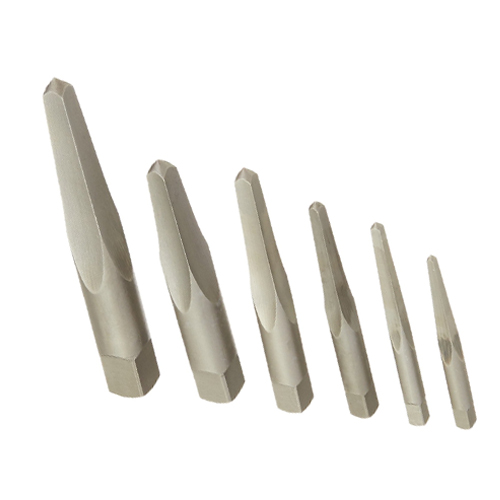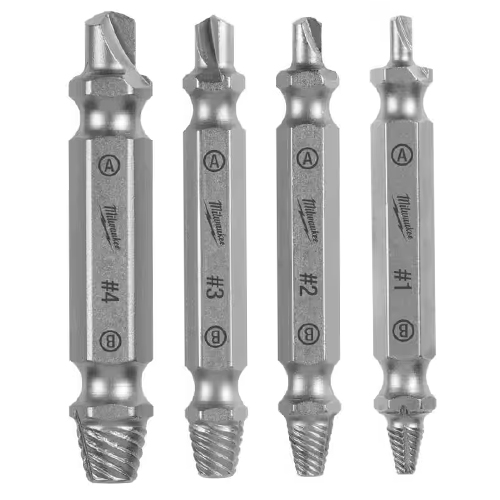Expert Guide to Screw Extractors: Remove Stuck Screws Like a Pro
Author:admin Date: 2025-03-26 07:25 Views:40
Introduction

Have you ever tried to unscrew a screw, but it won’t move? This is mostly because it was overtightened, rusted, or stripped. This makes it harder for ordinary screwdrivers to unscrew it. As such, you need screw extractors. They will help you easily deal with such a situation.
A screw extractor is a specialized tool with reversed thread whose job is to remove the stripped or broken screws without damaging its threads. The reverse thread helps with gripping the screw and removing it from a workpiece.
You will be surprised by how often people need to use screw extractor sets. That is why we give them the spotlight in this guide. We help you see the importance of such specialized tools, the types available, and how best to use the set to suit your needs.
Why Do Screws Get Stuck?
A screw extractor set is a key tool for anyone who works on DIY projects. There are many applications where you are likely to use it. Here are some of the reasons screws might get stuck, and you have to use an easy-out screw extractor.
- Rust can be a big reason to get the screw extractor kit. This is because when rust forms around the screw and the surrounding material, then the two bind together. This makes it hard to remove the screw.
- Thread adherence or galling is a phenomenon where the threads of a screw and the surrounding material cling together. This can make removing the screw nearly impossible.
- Having a stripped screw head makes it hard to turn the screw as the screwdriver would be unable to grip the screw tightly enough to turn it. A screw extractor from Home Depotcan help handle such stripped screw heads.
- Applying too much pressure or using the wrong bit size can also lead to binding or stripping of the screw. It would definitely need more force to get the screw loose.
- We cannot forget those who tend to overtighten the screws. This would strip the screw heads and sometimes bind with the surrounding material. It would probably needscrew extractors to remove such a screw.
Types of Screw Extractors and Uses
When seeking to get a Harbor Freight screw extractor or Lowes screw extractor, there will be many options for you to consider. Here is an overview of the various types of screw extractors.
Spiral Flute Screw Extractor

This is the most common extractor in the market. It is also called an easy-out screw extractor. It is characterized by having a tapered design with a reverse thread. Once it is inserted into the drilled screw, all you have to do is turn anticlockwise to move the stuck screw.
You may have to use more force depending on how tight the screw is. The more you apply the force, the better the extractor grips onto the screw.
We recommend it for removing stuck bolts and screws with broken heads. Also, this tool works best for softer metals such as brass and aluminum.
It might not be the best for the extremely hard metals. Using inferior-quality screw extractors can easily break in the screw, becoming even more challenging to remove it.
Straight Flute Screw Extractors

These have a different design compared to the others above. Rather than having spiraled threads, they come with parallel ridges that fit into the predrilled holes in the screw. They rely on the user’s torque to get the screw unstuck.
You can easily get the Home Depot screw extractor of this type and work on the harder metal projects, unlike the other choice above. Because of the design, breaking the extractor is possible. The last thing you need is a damaged screw extractor.
Such a screw extractor bit might also come in handy for industrial and machining applications where maintaining precision is important.
The potential downside is that this set might not work well for deeply stuck screws.
Multi-Spline Screw Extractors

If you need to handle tougher screw extractions, then consider the multi-spline extractors. They are designed to have more deep grooves or splines. These are key for strongly holding onto the stuck screws so that extraction is easier.
We recommend such an extractor for high-torque applications in case the other screw extractors keep slipping.
Due to their overall performance, you can come across them in the automotive sector.
Expect them to be more expensive because of their capabilities and build quality. They are generally more rugged.
Double-Ended Screw Extractor

This screw extractor bit comes with a unique design. This is because it combines drilling and extraction into a single tool. As such, use one side to make the pilot hole and then use the other side to slide into the hole firmly and start the extraction process.
Having an all-in-one solution should work for many people. However, they tend to have limited torque capability and can wear down quickly if overused.
Expect to come across other specialty screw extractors depending on the brand and manufacturer. Look at their description to find out if the screw extractor will be good for your application before buying.
How To Use A Screw Extractor: Step-by-Step Guide
Once you get your screw extractor from Lowes or any other shop, it is time to get to work. However, how do you use the screw extractor? Below is a guide to get you started.
- Start by making an indent into the stuck screw with the use of a center punch. A hammer should be enough to make the center punch make the indent. The work of the indent is to keep the drill bit or screw extractor from slipping.
- Next is to drill a hole at the center of the screw. Make sure you use a smaller drill bit than the size of the screw. Put the drill bit into the center punch indent and drill the screw for about ¼ inch.
- Insert the screw extractor into the drilled hole in the screw. If the extractor comes with a handle, insert it and start to turn anticlockwise to lock the extractor in position and unscrew the screw. You could still use a wrench to help with the grip.
- Consider using penetrating oil for the stubborn screws. Once you apply the penetrating oil, give it a few minutes to loosen the screw and try again. Sometimes you can heat the metal with a torch to help loosen the screw and see if this makes extracting easier.
How to Choose a Screw Extractor Set
Choosing the best screw extractor can determine how well you can work on projects with stuck screws. Here are a few tips on how to choose the right screw extractor.
Type of Materials and Screws
An Irwin screw extractor set will only be useful if you choose it based on its capabilities. That is why you have to consider the type of materials and screws you would be working on. Some extractors work best for the harder materials, while others can only handle soft materials.
Also, what type of screw are you working on? This is key to ensure you get the right extractor tip for the job.
The Size Range
Choosing a laptop screw extractor or any other application needs to have the best size range. This is because it allows you to handle several screw diameters.
The general rule of thumb is to have a smaller size than the screw you are trying to get unstuck. A smaller size is vital for proper engagement and subsequent removal.
Manufacturers often release reference charts. Look at these charts to find the right sizes that correspond to your screw sizes.
Construction and Quality
You can come across several brands using different materials to make the screw extractors. For example, you can find the HSS steel screw extractors. These extractors are made using high-speed steel, which is vital for more strength and durability.
Other than the material, look at the design as well. It can be a spiral or straight flute design. These common designs are quite effective at ensuring performance is maintained.
Getting screw extractors with rust resistance capabilities can be good for long-term use. With no rust, you should expect the best longevity as well.
Ease of Use
The choice of screw extractor can also be based on the ease of use. Having the reverse thread is often an easy way of removing the stuck screws. All you have to do is insert the extractor in the pilot hole and turn anticlockwise to lock it in place.
As part of the ease of using the set of screw extractors, consider one with a storage accessory. This helps keep the screw extractors from easily getting misplaced.
Best Practices for a Screw Extractor Set: Pro Tips

How you use the screw extractor remover can often determine how well it will do its job. Below are a few ideas on how to use the screw extractor tool.
- Always make sure you use the right type and size of the screw extractor. Not all extractors are made the same. For example, you can use the spiral flute extractor for the brittle and soft screws. Of course, the correct size is still important to remove the stuck screw with ease.
- Proper tools such as the drill, center punch, and penetrating oil can make the whole process smooth. However, as you can see, you may need additional tools to get the job done.
- Safety is still important. This includes stabilizing the workpiece so it does not move around each time you drill into it. Also, wear safety gear such as goggles and gloves to protect yourself in case there might be flying debris.
- Using the proper technique should help you a lot in removing the screw. Start with drilling a pilot hole so that you have a place to anchor the screw extractor and remove it safely without the extractor slipping all the time.
- Apply steady pressure while trying to remove the stuck screw. Sometimes, you may have to use penetrating oil or heat the metal if necessary. Forcing to turn the screw extractor is not recommended as sometimes you may end up breaking it.
How to Prevent Screws From Getting Stuck in the Future
Having to deal with stripped or stuck screws is no fun. Depending on how much the screw is stuck, you may find it quite a hassle to deal with. So, how do you prevent it from getting to this point?
Choosing the right screws for the job can be a start. We recommend using corrosion-resistant screws for applications involving humid or outdoor conditions. Rusting is what often makes the screws get stuck.
Applying some lubrication before tightening the screws can help create a barrier that prevents corrosion and reduces friction. A good example is using an anti-seize compound that keeps the screws from getting stuck, mainly when used for metal-to-metal applications.
It should be a no-brainer that you should not overtighten the screws during installation. Using a torque-limiting drill setting can keep the drill from overtightening the screws. Also, just tighten enough to hold the screws snug but not too much that it strips the screws.
Conclusion
Screw extractors remain important tools that most people should have. It is good to know just how easy it is to get them from common stores around us. This is whether online or from a physical store. As for how to use the screw extractors, you should find it being an easy process, as we have discussed above. Make sure to also take some steps in mind to avoid stripping or overtightening the screws so that the next time you need to remove a screw, the process is easy.


